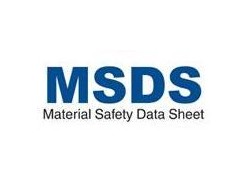MSDS Introduction
MSDS (Material Safety Data Sheet) is a chemical safety manual, which can also be translated as a chemical safety technical manual or chemical safety data sheet. The main content includes the physical and chemical parameters, hazardous characteristics, toxicity parameters, exposure limits, health and environmental hazards of hazardous substances.

1、 Definition of SDS/MSDS
SDS, also known as Safety Data Sheet in English, is a comprehensive document on chemical composition information, physicochemical parameters, ignition and explosion performance, toxicity, environmental hazards, as well as information on safe use, storage conditions, leakage emergency response, transportation regulations, and other aspects. It is also one of the mandatory information transmission carriers required by the EU REACH regulations.
MSDS is a comprehensive legal document provided by chemical production or sales enterprises to customers in accordance with legal requirements regarding the characteristics of chemicals. It provides 16 contents, including the physical and chemical parameters, explosive properties, health hazards, safe use and storage, leakage disposal, first aid measures, and relevant laws and regulations of chemicals. Currently, a document similar to MSDS, the International Chemical Safety Card (ICSC), has been developed by the International Program on Chemical Safety. Similar to MSDS, ICSC provides an overview of the health and safety use information related to chemicals. Nowadays, there are 1300 chemicals with ICSC. In addition to English, ICSC is also translated into 13 other languages. However, ICSC does not have government regulations for the management of chemicals, and certain warning standard terms (R-Phrases) are not applicable in some countries. So ICSC is not a legal document, it cannot replace the MSDS currently circulating internationally.
2、 The Status of MSDS in International Trade
The laws of developed countries such as the United States and Europe have extremely strict requirements for environmental and occupational health. In international trade of chemicals, customers often request MSDS from suppliers before purchasing chemicals.
Suppliers will comply with legal requirements and promptly provide MSDS that meet the legal and regulatory requirements of the customer's country. In the United States, Canada, and European countries, some large and medium-sized enterprises have hazardous chemical management departments or occupational health and environmental science management departments specialized in reviewing MSDS provided by chemical suppliers. Only those who meet the requirements after review are qualified to engage in the next step of business contact with the procurement department.
3、 The new GHS SDS is now abbreviated as the Safety Data Sheet, which includes 16 items:
| 1. CHEMICAL PRODUCT AND COMPANY IDENTIFICATION | 9. physicochemical properties |
| 2. Hazards identification | 10. Stability and reactivity |
| 3. COMPOSITION/INFORMATION ON INGREDIENTS | 11. toxicological information |
| 4. First-aid measures | 12. Ecological information |
| 5. Fire protection measures | 13. Waste disposal |
| 6. ACCIDENTAL RELEASE MEASURES | 14. TRANSPORT INFORMATION |
| 7. handling and storage | 15.Regulatory information |
| 8. handling and storage | 16. Other information |
4、 The regulatory versions of SDS/MSDS in various countries are as follows:
International: Sixth revised version of the United Nations GHS system, ISO international version
China: Chinese GB version
USA: OSHA version, ANSI version
EU: EU CLP version, EEC version
Canada: Canadian HPR version, WHMIS version
Japan: According to Japanese JIS Z 7253:2012
New Zealand: According to the New Zealand HSNO version
5、 What is the purpose of SDS/MSDS?
1. Customs inspection (whether the ingredients are prohibited items)
2. Freight forwarder declaration (understanding product transportation requirements)
3. Customer requirements (different regulations in different regions)
4. Enterprise Safety Management (Understanding Product Hazardous Characteristics)
5. Hazard registration (implementing strict safety supervision and management)
6、 Service content:
MSDS service: MSDS/chemical safety technical manual production, conversion, management, and translation;
GHS labels: Convert MSDS/SDS and hazard labels according to the latest GHS standards;
MSDS translation: supports 28 languages including Chinese, English, German, French, etc;
Certificate inquiry: Our company has issued an MSDS certificate, which can be found on the official website;